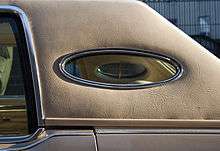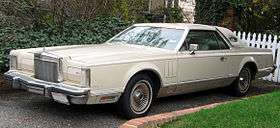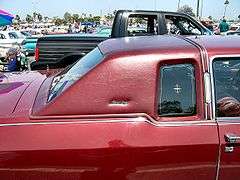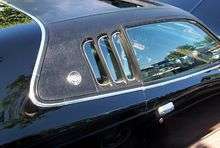Opera window
Opera windows are small, discrete, and fixed side windows in the C-pillar of some cars. Originally porthole-sized and shaped to provide light and rear passenger visibility in luxury 4-door sedans and limousines in the 1930s, they made a brief appearance in two-door coupes in the 1950s before becoming a sweeping design fad in the 1970s.

That era’s proliferation of heavy, typically vinyl-covered C—pillars opened the door to frantic copycatting[1] that ended up permanently blurring the distinction between traditional opera windows, which still are found, and rear quarter windows, rear door vent windows, sharply raked fastback and hatchback rear windows, wraparound windows, and other established rear window design trends and treatments.
History
Opera window
.jpg)

The design element of a distinct, fixed, centered opera window was borrowed from such windows in horse-drawn carriages, and used during the classical era of automobile styling. For example, “...the Elcar in 1924 was good looking...and even a fabric top in the style of a brougham with oval opera windows framed by landau bars....[2] Opera windows saw their demise in the 1930s. Perhaps the most notable return was the "porthole" in the 1956–1957 Ford Thunderbird. It was provided as an option to improve rear-quarter visibility with the removable hardtop in place...[3]
Opera windows began reappearing in the early 1970s in such vehicles as the 1972 Continental Mark IV, kicking off a brief copycat trend that often left the distinction between hybrid and rear windows that combined elements of traditional rear windows styling and true opera windows of the 1930s and 1950s.
“...The hottest thing going was the "porthole" window in the rear side pillar - called "opera windows" that came in during the horse and buggy [era]...[4] Most often, variants were applied on two-door hardtop or coupé models, spanning all types of vehicles from economy compacts to flagship personal luxury cars, in which latter exploding realm they became “recognition elements” seeking to add a vintage element to their styling.[5]
The windows were intended to offset the significant blind spots created by wide C-pillars that were characteristic of many American cars produced at this time.[6] In an age of decreasing dimensions and increasingly common use of non-opening rear side windows on 2-door models, a variety of shapes of rear windows may have helped passengers there to feel somewhat less claustrophobic.
These windows were usually non-functional; however, in the case of the AMC Matador coupe NASCAR racers, the small windows that came with the Barcelona II trim package actually helped to clean up the aerodynamics when such windows were open to the wind under racing conditions.[7]
In some cars, an additional feature was the so-called opera light that was mounted on the outside of the B-pillar or C-pillar and illuminated when the exterior lights were switched on. Opera windows had fallen out of vogue by the mid-1980s, as changing automotive styles moved away from the upright notchback. Smaller, more aerodynamic cars made opera windows appear gaudy or out of place. Contemporary examples of opera windows are sometimes found on modified or customized automobiles.
Quarter windows, hybrids and pseudo-opera windows
Some sample images of quarter windows, hybrids, and pseudo-opera windows that blurred the distinction between their placement and elements and those of traditional true opera windows:
 The 1978 Lincoln Continental Town Coupé - "Landau’s" fixed rear quarter window buried in a heavily padded, vinyl-covered, exceptionally wide C-pillar is an example of styling that blurred the distinction between rear quarter windows common on two and four door coupes and sedans and traditional discrete free-standing opera windows fitted in wide C-pillars.
The 1978 Lincoln Continental Town Coupé - "Landau’s" fixed rear quarter window buried in a heavily padded, vinyl-covered, exceptionally wide C-pillar is an example of styling that blurred the distinction between rear quarter windows common on two and four door coupes and sedans and traditional discrete free-standing opera windows fitted in wide C-pillars.- Rear window and padded Landau roof on a 1977 AMC Matador Barcelona coupe, another example of a hybrid or rear window that combined elements of traditional rear window styling with the brief fad for opera or pseudo-opera windows in the early and mid-‘70s.
 The flamboyant styling of this triple rear quarter window on a 1973 Dodge Charger SE coupe camouflages that it is really just continuing the tradition of a rectangular or raked rear window in a two-door car placed after the front door‘s roll-up window.
The flamboyant styling of this triple rear quarter window on a 1973 Dodge Charger SE coupe camouflages that it is really just continuing the tradition of a rectangular or raked rear window in a two-door car placed after the front door‘s roll-up window.
Examples
.jpg)
Cars with traditional opera windows mixed in with cars with other types
This is a partial list of both models that had opera windows as standard or optional feature and those which had hybrid or pseudo-opera windows:
- AMC Concord (1978–1982 coupe, 1980–1983 4-door sedan)[8]
- AMC Eagle coupe, 4-door (1980–1988)[9]
- Buick Regal coupe (1973–1977)
- Buick Riviera (1974–1978)
- Cadillac Coupe de Ville (1974–1979, 1985–1993)
- Cadillac Sedan de Ville (1975–1976)
- Cadillac Eldorado (1971–1978)
- Cadillac Fleetwood Brougham coupe (1980–1985)
- Cadillac Fleetwood coupe (1985–1986, 1989–1992)
- Cadillac Sixty Special coupe (1993)
- Cadillac Fleetwood 75 series (1971–1976, 1985–1987)
- Cadillac Fleetwood limousine (1977–1984)
- Chevrolet Caprice (1974–1976)
- Chevrolet Chevelle coupe (including Malibu and Laguna, 1973–1977)
- Chevrolet Concours coupe (1976–1977)
- Chevrolet Impala (1974–1976)
- Chevrolet Monte Carlo (1973–1977, 1981–1988)
- Chrysler Cordoba (1975–1983)
- Chrysler LeBaron coupe (1977–1986)
- Chrysler Newport (1976–1978)
- Chrysler New Yorker (1974–1978)
- Chrysler TC by Maserati (1989–1991)
- Continental Mark IV, V & VI (1972–1983)
- Daihatsu Charade Runabout (G10/20, 1978–1983)
- Dodge 400 (1981–1983)
- Dodge 600 coupe (1984–1986)
- Dodge Aries 2-door (1981–1989)
- Dodge Aspen coupe (1976–1980)
- Dodge Diplomat coupe (1977–1981)
- Dodge Magnum (1978–1979)
- Dodge Mirada (1980–1983)
- Dodge Monaco coupe (1977–1978)
- Dodge Royal Monaco coupe (1974–1977)
- Ford Elite (1974–1976)
- Ford Granada 2-door (1975–1980)
- Ford Mustang II Ghia (1975–1978)
- Ford LTD, Crown Victoria 2-door (1975–1987)
- Ford LTD II (1977–1979)
- Ford Thunderbird (1956–1957, 1973–1982, 2002–2005)
- Ford Torino 2-door (1974–1976)
- Imperial LeBaron coupe (1974–1975)
- Lincoln Continental (1975–1980)
- Lincoln Town Car (1981–1997)
- Mazda RX-5 (1975–1980)
- Mercury Cougar (1974–1982)
- Mercury Marquis, Grand Marquis 2-door (1979–1987)
- Mercury Monarch 2-door (1975–1980)
- Mercury Montego 2-door (1974–1976)
- Nissan Silvia S110 series 2-door coupe (1979–1983)
- Oldsmobile 88 (1974–1984)
- Oldsmobile 98 (1974–1987)
- Oldsmobile Cutlass coupe (1973–1977)
- Oldsmobile Cutlass Calais coupe (1981–1984)
- Oldsmobile Cutlass Salon coupe (1985–1988)
- Oldsmobile Cutlass Supreme (1973–1988)
- Oldsmobile Omega coupe (1975–1979)
- Oldsmobile Toronado (1974–1978)
- Pontiac Bonneville (1975–1979)
- Pontiac Catalina (1974–1976)
- Pontiac Grand Am coupe (1973–1977)
- Pontiac Grand Prix (1973–1987)
- Pontiac Grand Ville (1974–1975)
- Pontiac Lemans coupe (1973–1980)
- Pontiac Phoenix coupe (1977–1979)
- Pontiac Sunbird notchback coupe (1976–1980)
- Pontiac Ventura coupe (1975–1979)
- Plymouth Gran Fury (1974–1977)
- Plymouth Fury (1976–1978)
- Plymouth Reliant 2-door (1981–1989)
- Plymouth Volare coupe (1976–1980)
- Toyota Carina Van TA16V/19V (1975–1977)[10] - perhaps the only wagon with opera windows.
- Toyota Crown coupe (1979–1983)
Cars with hybrid and pseudo-opera windows
This is a list of vehicles that featured hybrid rear windows that blurred the distinction between rear quarter windows, rear door vent windows, and traditional opera windows, which are distinguishable by not mimicking or mixing with any established styling trends such as sharply angled or raked fastback and notchback windows, rear quarter windows, and wraparound rear windows.
- AMC Matador coupe: D/L Formal Window Package (1974–1975) and Barcelona (1976–1978)[11][12][13][14]
- Dodge Charger (1973–1978)
See also
Notes
- Cadillac Eldorado story, Retrieved on October 22, 2007.
- William S. Locke (2000) Elcar and Pratt Automobiles: The Complete History, McFarland & Company, ISBN 0-7864-0956-8, page 71.
- see the 1955-1957 Ford Thunderbird, Retrieved on July 7, 2007.
- Robert Szudarek (2000) The First Century of the Detroit Auto Show, SAE, ISBN 0-7680-0502-7, page 210.
- Paul A. Herd and Mike Mueller (1994) Charger, Road Runner, and Super Bee, MotorBooks/MBI Publishing Company ISBN 0-87938-844-7, Page 119.
- Dodge Magnum story, Retrieved on October 22, 2007.
- AMC Matador small window for NASCAR, Retrieved on October 22, 2007.
- Cranswick, Marc (2011). The Cars of American Motors: An Illustrated History. McFarland. p. 252. ISBN 9780786485703. Retrieved 10 January 2019.
- Flammang, James M. (1990). Standard catalog of American cars, 1976-1986 (Second ed.). Krause Publications. pp. 12–14. ISBN 9780873411332.
- カリーナバン 1400ー1600 [Carina Van 1400–1600] (in Japanese), Toyota, December 1975, p. 4, 135741—5012
- Auto Editors of Consumer Guide (26 October 2007). "1974-1978 AMC Matador". HowStuffWorks.com. Retrieved 10 January 2019.
- Sikora, Don (10 April 2013). "Review Flashback! 1975 AMC Matador". Consumer Guide. Retrieved 10 January 2019.
- "1976 AMC Full Line brochure". www.oldcarbrochures.com. p. 22. Retrieved 10 January 2019.
- DeMauro, Thomas A. (August 2018). "Majestic Matador - 1977 AMC Matador". Hemmings Classic Car. Retrieved 10 January 2019.